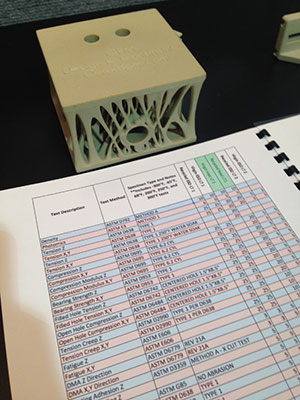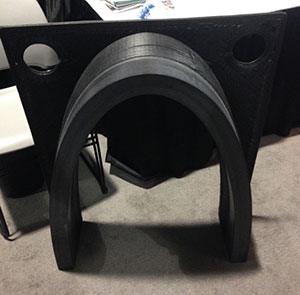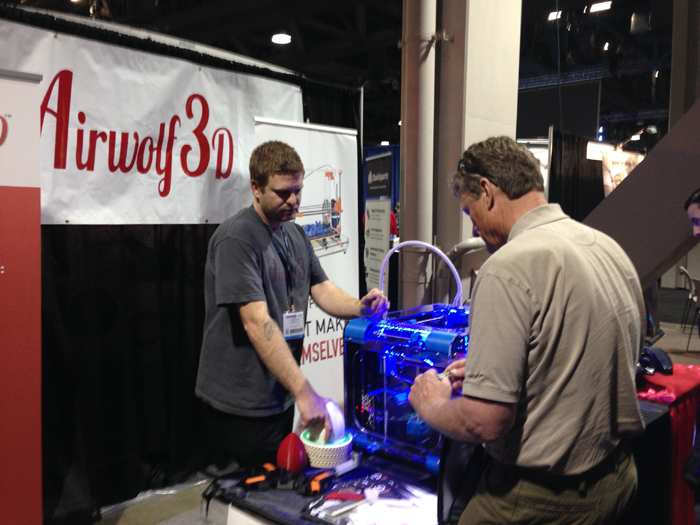There’s a strange thing that happens for a member of the press at an event like AeroDef, a convention for members of the aerospace and defense supply chain. They really don’t care about talking to a reporter or journalist because that’s not the sort of person that will buy a machine or broker some sort of business deal. So, though it’d be nice to sap every exhibitor and speaker for information, it’s pretty clear that they’d rather be networking. This is sort of the opposite effect that I’ve had at consumer-oriented 3D printing events, where exhibitors are excited to speak to me, partially as a member of the press who’s going to give them some publicity, but also just because there’s more of an open, friendlier vibe throughout. Still, I was able to learn a great deal about the place that additive manufacturing (AM) is at in the manufacturing supply chain from the AeroDef conference, put on in part by the National Center for Defense Manufacturing and Machining, the non-profit running the America Makes network.
From the perspective of many of those outside of 3D printing industry itself, you get the idea that AM is a new, kind of cute, sometimes exciting technology. From those inside of the 3D printing industry, you get the idea that some OEMs (original equipment manufacturers) are asleep at the wheel. One rep from a 3D printing service bureau actually used those words exactly, saying that a lot of people in the aerospace and defense industries are still to realize that additive manufacturing is the future.
I approached a few more traditional companies — materials suppliers, laser cutting and CNC bureaus, and other exhibitor booths that weren’t quarantined in the 3D printing area of the showroom floor — about their interest in 3D printing. Did they work with 3D printing companies to develop composites? Did they provide quality control systems for manufacturers that used AM? And, more often than not, the answer was “no”. A majority of the booths I talked to didn’t seem to have an interest in the technology. I thought it strange to be indifferent to an emerging technology that could earn them some money. After all, some 3D printing uses composite materials and many hope to 3D print more and more composites. Quality control is still relevant to additive manufacturing. And traditional machining is still required for the post processing of some 3D printed parts.
For instance, Lockheed Martin’s Brian Rosenberger explained that the company has been using AM since the 90’s. In fact, Lockheed Martin has long been taking advantage of Sciaky’s free form electron beam 3D printer that is capable of manufacturing huge titanium parts. Though their robotic arm, which welds metallic wire with an electron beam, can produce parts up to 22 feet long, the parts require post processing. In researching the 3D printing of F-35 jet parts, portions of the tail and wing, the company prints metal parts with an extra ¼” of material, which is then machined to fit the proper specifications.
Northrop Grumman’s current research into AM would also seem relevant to traditional members of the supply chain. Through partnerships and funding from America Makes, the company is conducting research around materials for 3D printing. By partnering with Oxford Performance Materials (OPM) to test PEKK and 3D Systems and Arkema to test PEEK, materials researcher Pedro Gonzalez explained that Northrop is building an intensive database that will collect all manner of material properties for aerospace and other high performance applications. This database will be available for all members of America Makes, a point Gonzalez used to sell the AM institute to his audience. In fact, America Makes has provided a lot of facilitation for these OEMs.

I spoke briefly with representatives from OPM, who told me about the materials research they’re performing. OPM had originally developed their materials for the critical field of medicine, making their PEKK 3D printing feedstock for implant-ready parts. Northrop Grumman had come to them to produce 3D printed parts for aerospace because no other company on the market had such a high performance material. Due to PEKK’s heat resistance and other characteristics, it was perfect for 3D printing a lightweight, efficient component. After accomplishing the task, Northrop was keen to develop their relationship with OPM further, including the creation of a material properties database. It wasn’t until both companies joined the America Makes network, however, that the funding was there to actually pursue the research.
If you’re familiar with America Makes, you know that it is a public-private entity, having received $30 million from the federal government and $40 million from the organization’s member companies and institutions. If you’re familiar with how R&D in the US works, then you’ll know that this isn’t the first partnership that’s been formed between government and corporations. I spoke with a representative at Oak Ridge National Laboratory, who recently partnered with Local Motors and Cincinnati Incorporated to help produce the first 3D printed car. As he explained it to me, Oak Ridge took an old experiment in 3D house printing out of storage and modified it for the Local Motors project. They were attempting to 3D print with concrete using a large RepRap style gantry. Retrofitting the machine to handle ABS-Carbon Fiber composites, the printer was ready for Local Motors task. Interestingly, the Oak Ridge printer doesn’t use plastic filament, but runs on plastic pellets, skipping one step in the manufacturing process and saving tons of money.
I asked the rep how funding for such a project works. Essentially, Oak Ridge Lab, and other government bodies like it, takes US tax dollars and applies it to research with which they will increase the global competitiveness of US companies. Oak Ridge will develop the technology, say a huge industrial FDM machine for car printing, and license it to a company like Cincinnati Inc. They’ll head to Cincinnati Inc., retrofit their giant laser cutters with an extruder head to 3D print Local Motors carbon fibre reinforced ABS parts, and then head onto a new research project. “Handing it off to industry”, as the rep put it. Meanwhile, as Oak Ridge is funded by the Department of Energy, another branch of the lab will be working on creating a more powerful, more affordable electric car battery that can hold a charge longer. Ten years down the line, hopefully, we’d have a lightweight car, thanks to the 3D printing research, that runs on electricity, thanks to other research. And the planet would be saved.

While I really liked talking to the Oak Ridge representative, I couldn’t help but wonder why more money wasn’t put into just making a sustainable car or, say, better public transportation to cut down greenhouse gasses much more quickly. He had tried to explain that they were trying to cover all of their bases, more or less, at the same time as they were addressing both short term and long term solutions to fossil fuels. In the short term, a lightweight car might save gas and, in the long term, they’d do away with gas altogether. He was the nicest guy at the convention and the most willing to talk to me forever, possibly because he didn’t need to rely on seeking out private business opportunities. He was content with his research.
I left the conversation wondering who had a say in our public dollars through these public-private partnerships. State governments hold similar relationships with companies, enticing high-tech industries to take root in their states with tax dollars. One representative from a 3D printing service bureau – the same surly fella who said a lot of OEMs are asleep at the wheel – explained that a 3D metal printing company might think of establishing themselves in Florida, where they wouldn’t be taxed. In fact, Florida might invite them to base their operations there by saying, “For every employee you hire locally, we’ll pay you $X,XXX.XX.” In his company’s case, they were invited to share a space with a college campus, where they might go about work as usual, while training students in direct metal laser sintering along the way. This provides students with a powerful set of tools for when they graduate. The only concern in my mind is what they will then do with those tools.
I met one government employee at the Department of Defense who works on incorporating small businesses into the missile defense supply chain. Every large OEM, like Lockheed or Raytheon or whoever, is obligated, when they sign a government contract, to make small manufacturers a part of their business. So, in producing a missile defense system, they’ll have to make sure that 20% of the system is produced by small companies. This mandate, legislated by Congress, seems like a good thing, in that it ensures that even the little guy gets a piece of the cake. At the same time, I couldn’t help but think of Eisenhower’s farewell warning. With a country that spends so much money on arms produced by the large OEMs, I now saw that the small manufacturers were absorbed into that industry as well.
During Pedro Gonzalez’s talk about materials research at Northrop, he explained how his company’s partnership with an educational outreach program is preparing students for 3D printing, providing classrooms with 3D printer kits and a useable curriculum so that, by the time they enter the workforce, they’ll have a handle on the technology. Their partner will even be hosting 3D printing summer camps that will introduce young people to the technology, too. This will certainly get young people familiar with 3D printing, even instill them with much needed workskills, but, when they get to work, I begin to imagine who they might find themselves working for.
Again, though, I’m not sure such public-private partnerships are all that new. What’s different is the technology that’s being assimilated into the same basic supply chain. This was something that Todd Grimm tried to explain to those who stopped by the AM resource center. He explained that the technology is new and exciting, but that it won’t cost anyone their jobs. They’ve just got to prepare for the integration of 3D printing into their already existing businesses.
Strangely enough, that may have been why MakerBot and Airwolf 3D were there. These small desktop machines, which are nothing in terms of output and price when compared to a $500k 3D metal printing machine, seemed completely out of place at an event for large OEMs. But, as one MakerBot spokesperson explained, it’s possible that an engineer, who isn’t too familiar with 3D printing, might stop by and purchase one for their desk. Or a manager of a large OEM might purchase a whole slew of machines for every engineer in their department, to get them used to playing with 3D printing so that they understood it better when the company started to adopt some 3D printing into their larger manufacturing practice.
Still, traditional manufacturers and large OEMs have some hurdles to leap over to use the technology in a big way. Todd Grimm thinks we’re about to get over the highest point of the hype cycle this year and, after that, everyone’s going to be hit with a deafening silence as 3D printing fails to deliver all of its promises. And it’s then, Todd says (I met him, so I can call him Todd. Plus, Rachel knows him from way back, so we’re practically besties), that the real work will get done. One of the major hurdles is adopting a common set of standards for the industry around 3D printing technology.
My surly friend thought that, though America Makes is supposed to help enable a shared set of standards, some companies won’t want to share their materials and 3D printing research with the rest. For instance, GE, he says, is launching its 3D printed LEAP nozzles, knowing that they meet GE’s standards, but without regard to the rest of the community. This seems to contradict Northrop Grumman’s and OPM’s shared materials database, that is supposed to be available to the rest of the America Makes members. The same surly friend also insisted that, as government employees, America Makes couldn’t care less about improving the industry because they just want to hang onto their government jobs. I don’t know if I agree with his assessment, but he’s clearly older and surlier than me.
As I delve further into the 3D printing supply chain, there are more tangled knots to be untied and I don’t know that I’m qualified to untangle them. I’m certainly biased in my own ways and occluded by inexperience. Hopefully, I’ll gradually come to understand the industry more and more, without becoming too surly in the process. Tomorrow’s another opportunity for me to get the down low on 3D printing, as it fits into the greater supply chain, as I’ll be speaking with Rep. Tim Ryan of Ohio’s 13th District, a man who played an essential role in establishing what is now known as America Makes.



